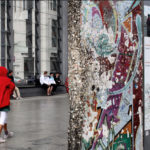Both individual and collective history is deposited where the events took place, inside the pages of time.
By assimilation places contain the history of which they were the stage and Europe in the 20th century was theatre of fatal and terrible events, in which Berlin played a central role. A role that such town has consciously assumed over the years, creating Memorials for the victims of Nazi-Fascism in many places.
This is why the investigation on Memory begins here in the heart of Europe.
Berlino Memoriali e Musei
Madrid
Madrid
Ceremony at the Western Cemetery
The descendants of the victims of Francoism and the survivors of the deportation to the Ravensbrück camp, accompanied by second generations, meet in the Western Cemetery of Madrid during the ceremony on 14 April, the anniversary of the proclamation of the Spanish Republic.
The nazi-camps. Which feasible photography?
Why these photographs? Why are concentration camps photographed? The risk that the images contain too much or too little is evident.
Through photography the ground, the objects and the structures themselves, where still available, can tell us about the darkest period of the twentieth century, going beyond pure representation, because these places pose questions about the very concept of humanity.
We ask photography to find answers to an inner investigation because the encounter with ta nazi-camp is not just visiting a place, but meeting ourselves.
Majdanek
The “Konzentrationslager Lublin Majdanek” was established at 4 kilometres from the centre of Lublin, on a specific order of Himmler on 30 July 1941, with a capacity of 20/25,000 deportees. It was gradually expanded to contain about 100,000 prisoners at the end of 1943.
Designed as a prison camp, originally intended for Poles, Soviet and Belarusian prisoners of war, Majdanek became a real extermination camp where thousands of men, women and children from all backgrounds were suppressed by every means – shot, hanged, drowned, gassed in the seven gas chambers and then burned in the five crematoria. On the 3rd November 1943, 18,400 Jews were killed within nine hours, whose bodies were thrown into mass graves previously dug by the deportees themselves.
In February 1944 the evacuation of the camp began, with transfers mainly to Auschwitz, Ravensbrück and Gross-Rosen. On 21 July the last execution of 700 prisoners took place and on 23 July the Soviet troops entered the camp where they found 1,500 survivors. It was the first camp to be liberated.
Sachsenhausen
Built in 1936 near Berlin, the Sachsenhausen camp was immediately placed under the control of the SS as a model camp both from an organization and training aspects destined to commanders and personnel to be sent to other camps. About 200,000 people were deported there, half of whom lost their lives.
In a part of the camp there was the The Concentration Camp Inspectorate, from which orders for other camps in Germany and other invaded countries were issued.
Sachsenhausen was the site of the largest banknote counterfeiting operation in history, known as Operation Bernhard, aimed at creating inflation and destroying Britain’s economy.
After the end of the war and the surrender of the Nazis, Sachsenhausen became a Special Camp under the control of the Soviets both for prisoners of war and opponents and remained in operation until 1950 when the GDR troops were installed.
In 1961 the National Memorial and Sachsenhausen Memorial was established and expanded several times.
Ravensbrück
In late autumn 1938, 500 prisoners from the Sachsenhausen concentration camp were transported to the shores of Lake Schwed, 80 km north of Berlin, for the construction of the largest concentration camp for women.
In the years 1939-1945, about 130,000 women and children from 40 nations were interned at Ravensbrück, 20,000 men in a neighbouring camp and 1,200 girls in the nearby Uckemark camp.
Ravensbrück, like other camps, gradually became a place of re-education and punishment for German women (political opponents, common prisoners, disabled, Jews, Jehovah’s Witnesses), and later a forced labour camp (for Siemens & Halske) and extermination by means of labour, gas chambers and hardship.
In 1942 the first experiments on human guinea pigs began in Ravensbrück too, in the hospital-infirmery. Sterilisations, abortions, artificial infections, surgical operations, all practices of which there are not only testimonies, but also incontrovertible evidence.The Red Army on 30 April 1945 liberated the camp, where 3000 sick women and men and a few children had been left.
Until the fall of the Berlin Wall the Soviet troops settled in the camp.












































